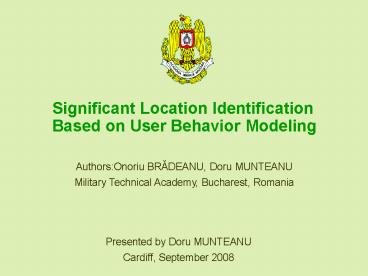Significant Location Identification Based on User Behavior Modeling PowerPoint PPT Presentation
1 / 22
Title: Significant Location Identification Based on User Behavior Modeling
1
Significant Location Identification Based on User
Behavior Modeling
AuthorsOnoriu BRADEANU, Doru MUNTEANU Military
Technical Academy, Bucharest, Romania
- Presented by Doru MUNTEANU
- Cardiff, September 2008
2
Presentation outline
- LBS technology for successful service creation
- Human behavior modeling
- Service design
- Significant Location Identification Algorithm
- Experimental results
- Conclusions
3
LBS-Services Success factors
Image here
- Classic Cell-ID algorithms may be improved?
4
LBS Solutions
- Technology requirements
- Yield
- Consistency
- Accuracy
- TTFF
- Handset
- Efficiency
- Expansion
- Compatibility
- Overall cost
- Terminal based solutions
- GPS (high acc.)
- SIM measurements (moderate acc.)
- Expensive terminals, compatibility issues.
- Niche market
- Network based solutions
- Dedicated infrastructure (high acc.)
- Cell ID (low acc.)
- Sensitive to network elements density.
- Consumer market
5
Contents
- LBS technology for successful service creation
- Human behavior modeling
- Service design
- Significant Location Identification algorithm
- Experimental results
- Conclusions
6
Human behaviour - gt stocked in a daily routine
- Human activity factors
- Intrinsic factors
- Extrinsic factors
- Correlation factors
- Gender
- Age group
- Employment status
- Municipality type
- Day of weak
- Season
7
Time-space allocation of daily activities
At home
8
Network daily traffic pattern
Call attempts from HOME
9
Contents
- LBS technology for successful service creation
- Human behavior modeling
- Service design
- Significant Location Identification algorithm
- Experimental results
- Conclusions
10
Service environment
Service diagram
HLR Home Location Register
MSC Mobile-services Switching Center
OSS Operation and Support System
VLR Visitor Location Register
GIS Geographic Information System
POS Point of Sale
ALR Application and Location Recognition
KDB Knowledge Data Base
11
Contents
- LBS technology for successful service creation
- Human behavior modeling
- Service design
- Significant Location Identification Algorithm
- Experimental results
- Conclusions
12
Block diagram of the proposed algorithm
Service Provisioning
Traffic monitoring
Consistency check
13
Method for computing the new radio profile
Processing
New profile
Profile adjustment
Signalling-traffic monitoring
Select the time-space pattern
Clustering
Select affected profiles
Network changes
14
Contents
- LBS technology for successful service creation
- Human behavior modeling
- Service design
- Significant Location Identification Algorithm
- Experimental results
- Conclusions
15
Urban environment - BucharestLoPC Example
Profile LoPC Profile Area sqkm Zone Size km Service stability
Initial C3, C4, C12,C29, C30, C31, C32, C33, C34, C35 2.67 0.92 92
16
Parameters computed during monitoring time
Distance The distance between the home and sites locations.
Activity The number of call attempts served by corresponding cells.
Frequency The number of distinct usage days.
Image here
17
Clustering cells using K-means partitioning
Traffic Data collection
Cells clusterization
18
Further Cell ID list adjustment
Profile LoPC Profile Area sqkm Zone Size km Service stability
Initial C3, C4, C12,C29, C30, C31, C32, C33, C34, C35 2.67 0.92 92
Tuned C3,C5, C6,C12, C7,C13, C4,C16 0.76 0.49 99
Shrunk C3,C5, C6,C12 0.42 0.33 95
Truncated C3, C12, C4 0.36 0.23 92
19
Tuned profile experimental results
Average zone size km
No Zone type Stabi-lity Initial profile Initial profile Tuned profile Tuned profile
No Zone type Stabi-lity Zone Area sqkm Zone size km Zone Area sqkm Zone size km
1 U 100 8,49 1,64 1,84 0,76
2 S 100 25,90 2,87 0,60 0,44
3 R 100 127,19 6,36 50,08 3,99
4 U 100 2,48 0,89 0,95 0,55
5 U 95 11,49 1,91 9,60 1,75
6 S 100 38,61 3,50 30,76 3,13
7 S 97 43,24 3,71 7,45 1,54
8 R 100 55,20 4,19 16,03 2,26
9 U 100 19,92 2,51 25,43 2,85
10 U 99 7,82 1,57 1,23 0,63
URBAN SUB-URBAN RURAL
20
Contents
- LBS technology for successful service creation
- Human behavior modeling
- Service design
- Significant Location Identification Algorithm
- Experimental results
- Conclusions
21
Conclusions
- Human behaviour information may be usefull in
location-aware applications within PLMN
environments - The proposed method could significantly improve
the quality of LBS services - Quality-of experience/business case tradeoff
- significant zone size reductions, up to 50,
- service availability improvements, up to 99
- The method is robust to network changes
- Has the potential to add value to any kind of
location-based services
22
Thank you!

